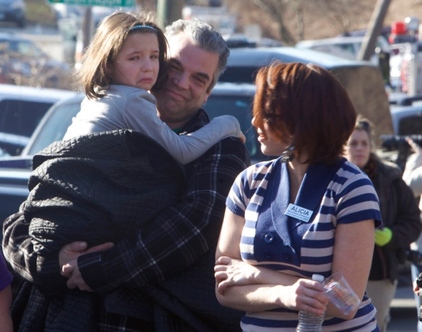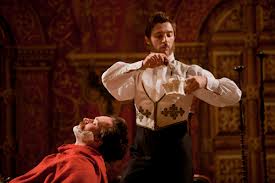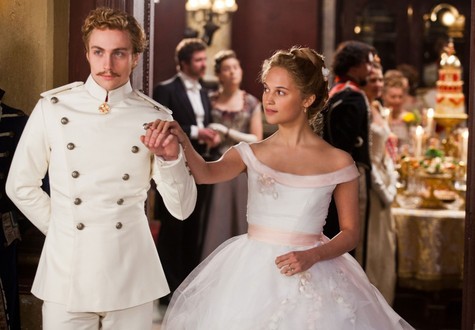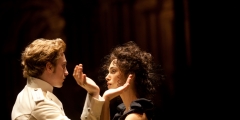foot in mouth: December 2012 Archives
Love and the Law, or, what the NRA and public mourning have in common.
December 17, 2012 1:10 AM
| Permalink
I didn't find out about the Sandy Hook shootings until Friday at 3 pm, when I entered my class at FIT to find my students listening to President Obama's brief address on YouTube. I let them listen, then turned it off.
Later I wondered why I had been in such a rush (not that they minded, it turned out; they'd probably been "processing", as educators like to say about the un-process-able, all day.) And later I looked at the photos of parents hugging and carrying off the children that did survive and cried. However terrible those parents must have felt about what happened to the other children, it couldn't have been equal to their relief that their own child was spared.
MICHELLE MCLOUGHLIN/REUTERS
That's the thing about love: equanimity has nothing to do with it. Your own child matters more to you than 20 of someone else's. And that's where the law comes in: it is supposed to protect the polity from fierce biases. Everyone's child gets to live.
But too many Americans have their particularities and their generalities mixed up. They think the law should protect our individual freedoms more than our collective rights. And a symptom of that confusion is not only insisting on your average maniac's right to bear arms but also the mass mourning we go in for. We take mass action not for what it is good for--large, gross necessities--but for delicate and differentiated feeling. In America we have a ghoulish habit of mourning vicariously, which both obscures the pain of those closely involved and makes us feel we are doing something.
Let the families do the mourning. The rest of us should be shocked and angry--thwarted enough from easy expressions of sympathy to be pressed to act and protest--at the senselessness of these children's deaths. No one outside the military (I'll leave inside for another day) should have access to a semi-automatic rifle that can fire seven shots a second and has hundreds of bullets ready in its magazine. The children's bodies were riddled with bullets.
December 17, 2012 12:53 AM
| Permalink
Anna Karenina dancing; plus links to several recent Financial Times reviews
December 8, 2012 7:26 PM
| Permalink
In the ballroom scene, for example, the dancers do not approximate the 19th century waltz so much as present what the waltz would look like if it still carried its original frisson. Cherkaoui blows the waltz's grace notes up big: it's fantastic in every sense of the word.
The film opened in London before I knew about it, so I missed my chance to write on it for the Financial Times, but Focus Features, the American producers, kindly let me interview Cherkaoui for their website. Here's the middle chunk of that profile. (I mention earlier in the piece that Wright sets the bulk of the action in a theater: catwalks, dressing rooms, auditorium and behind the proscenium. Here's a 5-minute doc/teaser on the film's creation that gives some idea.)
Anna Karenina begins with the well-positioned bureaucrat Oblonsky (Matthew Macfadyen) laid out in a barber's chair on a bare stage.
It is fitting in this starkly theatrical setting that the barber (Elias Lazaridis, one of thirteen dancers in the film from Cherkaoui's Antwerp-based troupe, Eastman) behaves like a matador, snapping the barber's sheet like a cape and flourishing the razors like lances. Mundane routine as ritual blood sport: how dangerous a world ringed round by custom can be.
And how mechanical: we follow Oblonsky, fresh from his ablutions, to the long chamber over which he presides, where row upon row of buttoned-up clerks stamp and rearrange papers in a syncopated ballet blanc: stamp, stamp, flutter of paper; repeat; repeat; repeat. The thick stack on the left shrinks as the thin stack on the right grows. "Paperwork," Oblonsky later exclaims, "is the soul of Russia." As he passes each row, his minions rise like pistons in a well-oiled machine to the music's chug and wheeze.
If the opening scenes establish the world we're in (richly adorned, deeply sublimated, and minutely calibrated) and how its story will be told (ebulliently, inventively, and, above all, theatrically), the ball -- in which Vronsky (Aaron Taylor-Johnson) and Anna (Keira Knightley) whirl themselves into a passion and cast Kitty (softly radiant Alicia Vikander) aside -- carries us into the story's romance. Most directors appreciate the scene's importance without making much of the dancing. (A notable exception is the 1935 Greta Garbo version, in which the dancers exchange not only partners but salty badinage.) Wright hands this pivotal moment over to the dance.
Cherkaoui set himself the task of inventing a variation on the waltz that would re-awaken it in all its allure. When he went "back into the books," he says, "I read a lot about how the waltz was considered indecent. Not proper. It came from Poland" -- a colonial outback by Russian lights -- "but it seeped into the aristocracy, and people would do it because they couldn't help themselves.
"I've always found this relationship between popular and aristocratic culture interesting. And here I was playing between these two: how we transform something to make it more proper but how at the end of the day it is still a man and a woman and their desire to fly away together.
"Waltzes can be like a cosmos," he continues, "all these couples twirling around each other but also around the other couples. You would lean in to the arm of your partner in such a way that both partners have the feeling they have no weight." They could spin all the way to the moon. They could fly too close to the sun. That thrill and danger resounds in the waltzes of Brahms, Tchaikovsky, Mahler, Ravel -- and Marianelli, whose waltz for Anna and Vronsky grows progressively discordant the faster it turns.
"Anna and Vronsky's passion is at the heart of the waltz," Cherkaoui notes. The other couples freeze until the duo -- "generating an energy like some kind of organic clockwork" -- sweeps them along in its wake.
The choreographer did not meddle with the patterns of the feet -- they lend the waltz its necessary force -- but he embellished the arms and upper body to bring out the waltz's strict comportment as well as its erotic appeal and to adapt it for the camera, which generally favors faces -- "how people look at each other" -- over feet.
To underscore the form's exacting rules of engagement, he accented the man's initial move: the raising of the back of the wrist to lead the woman on to the dance floor. Cherkaoui has the man's wrist suddenly jut up. It doesn't bode well for the lady otherwise. When Vronsky spots Anna after he has already agreed to give Kitty a turn, he lifts his wrist so desultorily that you feel the insult.
Bored Vronsky, entranced Kitty
As for the waltz's legendary raciness, Cherkaoui began by thinking about the prescribed limits to touch at the 19th century ball: "You would hold the hand without the palms touching." Only fingers were clasped. "Touching the inside of the hand was considered very intimate, very sensual." In his version, only the lower arm's pale undersides graze.
The hands are free to undulate and unfurl like time-lapse vines winding up trellises and flowering. "The looseness of the wrist only suggests touch. The hands flow through one another like weaving. I wanted the waltz to be magical, and you know how when you cast a spell it is with the weaving of hands?"
For more on Cherkaoui himself as well as his work on the film, including his coaching of the actors, click here.
*********
On another note, I have ten reviews written for the Financial Times in the last few months that I have yet to post. Some links:
--The Garth Fagan/Wynton Marsalis premiere at BAM, with evocative witchy sets by Alison Saar
--Philadanco at the Joyce with Rennie Harris's new Wake Up and Ronald K. Brown's enduring Gatekeepers
--At New York City Ballet, the Stravinsky-Balanchine Greek dyad Apollo and Orpheus and a spectacular debut in New York City for Justin Peck, with a score by Sufjan Stevens.
--At American Ballet Theatre, the first of Alexei Ratmansky's triad to Shostakovich symphonies.
--At the BAM opera house, Londoner Hofesh Shechter's Political Mother in his company's New York debut and Pina Bausch's final work.
--The bharatanatyam master Malavika Sarukkai at the Baryshnikov Arts Center as part of the White Light Festival
--On the experimental end, Tere O'Connor at New York Live Arts and Miguel Gutierrez and the Powerful People at BAM's small new space.
Enjoy!
AJ Blogs
AJBlogCentral | rssculture
About Last Night
Terry Teachout on the arts in New York City
Terry Teachout on the arts in New York City
Artful Manager
Andrew Taylor on the business of arts & culture
Andrew Taylor on the business of arts & culture
blog riley
rock culture approximately
rock culture approximately
critical difference
Laura Collins-Hughes on arts, culture and coverage
Laura Collins-Hughes on arts, culture and coverage
Dewey21C
Richard Kessler on arts education
Richard Kessler on arts education
diacritical
Douglas McLennan's blog
Douglas McLennan's blog
Dog Days
Dalouge Smith advocates for the Arts
Dalouge Smith advocates for the Arts
Flyover
Art from the American Outback
Art from the American Outback
lies like truth
Chloe Veltman on how culture will save the world
Chloe Veltman on how culture will save the world
Life's a Pitch
For immediate release: the arts are marketable
For immediate release: the arts are marketable
Mind the Gap
No genre is the new genre
No genre is the new genre
Performance Monkey
David Jays on theatre and dance
David Jays on theatre and dance
Plain English
Paul Levy measures the Angles
Paul Levy measures the Angles
Real Clear Arts
Judith H. Dobrzynski on Culture
Judith H. Dobrzynski on Culture
Rockwell Matters
John Rockwell on the arts
John Rockwell on the arts
State of the Art
innovations and impediments in not-for-profit arts
innovations and impediments in not-for-profit arts
Straight Up |
Jan Herman - arts, media & culture with 'tude
Jan Herman - arts, media & culture with 'tude
dance
Foot in Mouth
Apollinaire Scherr talks about dance
Apollinaire Scherr talks about dance
Seeing Things
Tobi Tobias on dance et al...
Tobi Tobias on dance et al...
jazz
Jazz Beyond Jazz
Howard Mandel's freelance Urban Improvisation
Howard Mandel's freelance Urban Improvisation
ListenGood
Focus on New Orleans. Jazz and Other Sounds
Focus on New Orleans. Jazz and Other Sounds
Rifftides
Doug Ramsey on Jazz and other matters...
Doug Ramsey on Jazz and other matters...
media
Out There
Jeff Weinstein's Cultural Mixology
Jeff Weinstein's Cultural Mixology
Serious Popcorn
Martha Bayles on Film...
Martha Bayles on Film...
classical music
Creative Destruction
Fresh ideas on building arts communities
Fresh ideas on building arts communities
The Future of Classical Music?
Greg Sandow performs a book-in-progress
Greg Sandow performs a book-in-progress
Overflow
Harvey Sachs on music, and various digressions
Harvey Sachs on music, and various digressions
PianoMorphosis
Bruce Brubaker on all things Piano
Bruce Brubaker on all things Piano
PostClassic
Kyle Gann on music after the fact
Kyle Gann on music after the fact
Sandow
Greg Sandow on the future of Classical Music
Greg Sandow on the future of Classical Music
Slipped Disc
Norman Lebrecht on Shifting Sound Worlds
Norman Lebrecht on Shifting Sound Worlds
The Unanswered Question
Joe Horowitz on music
Joe Horowitz on music
publishing
book/daddy
Jerome Weeks on Books
Jerome Weeks on Books
Quick Study
Scott McLemee on books, ideas & trash-culture ephemera
Scott McLemee on books, ideas & trash-culture ephemera
theatre
Drama Queen
Wendy Rosenfield: covering drama, onstage and off
Wendy Rosenfield: covering drama, onstage and off
visual
Aesthetic Grounds
Public Art, Public Space
Public Art, Public Space
Another Bouncing Ball
Regina Hackett takes her Art To Go
Regina Hackett takes her Art To Go
Artopia
John Perreault's art diary
John Perreault's art diary
CultureGrrl
Lee Rosenbaum's Cultural Commentary
Lee Rosenbaum's Cultural Commentary





Recent Comments